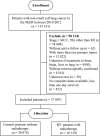Radiotherapy improves the survival of patients with stage IV NSCLC: A propensity score matched analysis of the SEER database
- PMID: 30239162
- PMCID: PMC6198236
- DOI: 10.1002/cam4.1776
Radiotherapy improves the survival of patients with stage IV NSCLC: A propensity score matched analysis of the SEER database
Abstract
Objectives: The survival advantage of radiotherapy (RT) for patients with stage IV non-small cell lung cancer (NSCLC) has not been adequately evaluated.
Methods: We analyzed stage IV NSCLC patients enrolled from the Surveillance, Epidemiology, and End Results (SEER) registry through January 2010 to December 2012. Propensity score (PS) analysis with 1:1 nearest neighbor matching method was used to ensure well-balanced characteristics of all comparison groups by histological types and metastatic sites. Kaplan-Meier and Cox proportional hazardous model were used to evaluate the overall survival (OS), cancer-specific survival (CSS), and corresponding 95% confidence interval (95%CI).
Results: Generally speaking, there was a trend toward improved OS and CSS for using RT to stage IV NSCLC patients for any metastatic sites and for any histological types except adenocarcinoma (AD). Radiotherapy significantly improved the survival of NSCLC patients with metastasis to brain (P < 0.001), especially for AD (P < 0.001). For stage IV lung cancer patients with squamous cell carcinoma (SQC), RT for any metastatic sites could universally improve the OS (P < 0.001) and CSS (P < 0.001). In particular, RT was also associated with improving OS (P < 0.001) and CSS (P = 0.012) for stage IV patients with metastases of two or more sites, ie, polymetastatic disease. Furthermore, for those stage IV SQC patients without metastasis, RT, most likely to the primary site, also significantly improved the survival (P < 0.001).
Conclusions: The results support that RT might improve the survival of patients with metastatic NSCLC in a PS-matched patient cohort from the large SEER database. It is prudent to carefully select patients for RT in metastatic NSCLC.
© 2018 The Authors. Cancer Medicine published by John Wiley & Sons Ltd.
Figures
Similar articles
-
Radiotherapy improves the survival of patients with metastatic esophageal squamous cell carcinoma: a propensity score matched analysis of Surveillance, Epidemiology, and End Results database.Dis Esophagus. 2019 Jan 1;32(1). doi: 10.1093/dote/doy074. Dis Esophagus. 2019. PMID: 30277502
-
Radiotherapy Improves the Survival of Patients With Metastatic Cervical Cancer: A Propensity-Matched Analysis of SEER Database.Int J Gynecol Cancer. 2018 Sep;28(7):1360-1368. doi: 10.1097/IGC.0000000000001313. Int J Gynecol Cancer. 2018. PMID: 30036221
-
Radiotherapy improves the survival of patients with extensive-disease small-cell lung cancer: a propensity score matched analysis of Surveillance, Epidemiology, and End Results database.Cancer Manag Res. 2018 Nov 29;10:6525-6535. doi: 10.2147/CMAR.S174801. eCollection 2018. Cancer Manag Res. 2018. PMID: 30555258 Free PMC article.
-
Addition of radiotherapy to the primary tumour in oligometastatic NSCLC: A systematic review and meta-analysis.Lung Cancer. 2018 Dec;126:194-200. doi: 10.1016/j.lungcan.2018.11.017. Epub 2018 Nov 13. Lung Cancer. 2018. PMID: 30527187
-
Hepatoid adenocarcinoma of the lung: An analysis of the Surveillance, Epidemiology, and End Results (SEER) database.Open Med (Wars). 2021 Jan 22;16(1):169-174. doi: 10.1515/med-2021-0215. eCollection 2021. Open Med (Wars). 2021. PMID: 33585692 Free PMC article. Review.
Cited by
-
Survival benefit of thoracic radiotherapy plus EGFR-TKIs in patients with non-oligometastatic advanced non-small-cell lung cancer: a single-center retrospective study.Ther Adv Med Oncol. 2023 Mar 21;15:17588359231161411. doi: 10.1177/17588359231161411. eCollection 2023. Ther Adv Med Oncol. 2023. PMID: 36970112 Free PMC article.
-
Establishment and validation of nomograms for predicting survival of lung invasive adenocarcinoma based on the level of pathological differentiation: a SEER cohort-based analysis.Transl Cancer Res. 2023 Apr 28;12(4):804-827. doi: 10.21037/tcr-22-2308. Epub 2023 Apr 7. Transl Cancer Res. 2023. PMID: 37180650 Free PMC article.
-
A narrative review of evolving roles of radiotherapy in advanced non-small cell lung cancer: from palliative care to active player.Transl Lung Cancer Res. 2020 Dec;9(6):2479-2493. doi: 10.21037/tlcr-20-1145. Transl Lung Cancer Res. 2020. PMID: 33489808 Free PMC article. Review.
-
Moxibustion Treatment, Alongside Conventional Western and Chinese Herbal Medical Therapies, May Improve Survival in Stage-IV Pulmonary Adenocarcinomas in a Dosage-Dependent Manner: A Prospective Observational Study With Propensity Score Analysis.Integr Cancer Ther. 2025 Jan-Dec;24:15347354251342739. doi: 10.1177/15347354251342739. Epub 2025 Jun 19. Integr Cancer Ther. 2025. PMID: 40537919 Free PMC article.
-
Squamous cell carcinoma predicts worse prognosis than adenocarcinoma in stage IA lung cancer patients: A population-based propensity score matching analysis.Front Surg. 2022 Aug 23;9:944032. doi: 10.3389/fsurg.2022.944032. eCollection 2022. Front Surg. 2022. PMID: 36090323 Free PMC article.
References
-
- Schiller JH, Harrington D, Belani CP, et al. Comparison of four chemotherapy regimens for advanced non‐small‐cell lung cancer. N Engl J Med. 2002;346(2):92‐98. - PubMed
-
- Cohen MH, Williams GA, Sridhara R, et al. United States food and drug administration drug approval summary: Gefitinib (ZD1839; Iressa) tablets. Clin Cancer Res. 2004;10(4):1212‐1218. - PubMed
-
- Thomas A, Liu SV, Subramaniam DS, Giaccone G. Refining the treatment of NSCLC according to histological and molecular subtypes. Nat Rev Clin Oncol. 2015;12(9):511‐526. - PubMed
-
- Morgensztern D, Waqar S, Subramanian J, Gao F, Govindan R. Improving survival for stage IV non‐small cell lung cancer: a surveillance, epidemiology, and end results survey from 1990 to 2005. J Thorac Oncol. 2009;4(12):1524‐1529. - PubMed
Publication types
MeSH terms
LinkOut - more resources
Full Text Sources
Other Literature Sources
Medical


